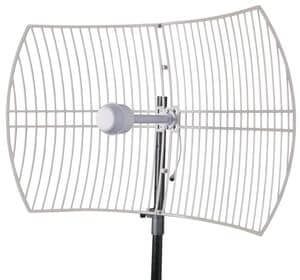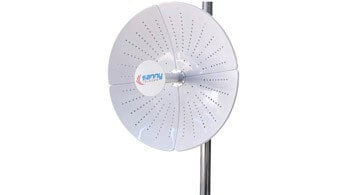In the realm of wireless networking, the significance of directional WiFi antennas cannot be overstated. Unlike their omni-directional counterparts that disperse signals in all directions, directional antennas focus the signal in a specific direction, thereby enhancing the range and quality of the connection. This feature makes them ideal for scenarios where the WiFi signal needs to be targeted over long distances or when it’s crucial to improve the signal quality by minimizing interference. In this article, we delve into the top 8 types of directional WiFi antennas, exploring their unique characteristics and applications.
Yagi-Uda Antenna
The Yagi antenna was invented in the early 1920s by Japanese engineer Hidetsugu Yagi and his colleague Shintaro Uda. It quickly gained popularity due to its simplicity and effectiveness.

The main element of the Yagi antenna is the boom, which is a long metal rod or tube that serves as the backbone of the antenna. The boom is typically made of aluminum or another lightweight and conductive material. The boom is usually mounted horizontally, although vertical and slanted orientations are also possible.
Attached to the boom are a series of shorter elements called directors and reflectors. The directors are positioned in front of the boom, while the reflector is placed behind it. These elements are typically made of metal rods or tubes and are also made of conductive material.
The directors and the reflector are responsible for focusing the antenna’s energy into a narrow beam. The directors are slightly shorter than the driven element (the element connected to the feedline), while the reflector is slightly longer. This configuration causes the radio waves to be concentrated in one direction, enhancing the antenna’s gain and directivity.
The driven element is connected to the feedline, which is the cable that carries the radio frequency signal to and from the antenna. The feedline is usually connected to the boom at a specific point called the feed point. The feed point is located at the center of the driven element or slightly off-center, depending on the desired characteristics of the antenna.
The Yagi antenna can be designed for different frequencies by adjusting the length and spacing of the elements. The spacing between the elements affects the antenna’s directivity and gain, with narrower spacing providing higher directivity and gain.
Yagi antennas are commonly used for television reception, radio communication, and wireless networking. They are particularly useful in situations where a strong and focused signal is required. Due to their directional nature, Yagi antennas can help reduce interference from other sources and improve signal strength over long distances.
In summary, the Yagi antenna is a highly directional antenna that consists of a long boom with multiple shorter elements attached. It is known for its excellent range and directivity, making it a popular choice for point-to-point connections and applications where a focused beam is needed.
Parabolic Grid Antenna
The parabolic grid antenna consists of a metal grid reflector that is shaped like a parabola. The grid is made up of metal rods or wires that are arranged in a grid pattern. The parabolic shape of the reflector allows the antenna to focus the radio waves into a narrow beam, which increases the gain and directivity of the antenna.

The parabolic grid antenna is commonly used for long-distance point-to-point wireless links. It is particularly effective in areas where there is a need for a high gain antenna that can withstand strong winds. The grid design of the reflector reduces the weight and wind load of the antenna, making it more suitable for areas prone to high winds.
The parabolic grid antenna is typically mounted on a pole or tower and is pointed directly at the target location. The narrow beamwidth of the antenna allows for precise aiming, which is important for long-distance links. The high gain of the antenna also helps to overcome the losses associated with long-distance transmission.
Overall, the parabolic grid antenna is an excellent choice for long-distance point-to-point wireless links. Its high gain and directivity, along with its lightweight and low wind load design, make it ideal for areas prone to high winds.
Panel Antenna
They are often used to improve WiFi coverage in specific areas such as outdoor patios, large rooms, or offices on different floors of a building. Panel antennas are typically mounted on walls or ceilings, and they can be adjusted to point in the desired direction. This allows the WiFi signal to be focused on a specific area, improving the strength and quality of the signal. Panel antennas are a popular choice for WiFi installations in hotels, restaurants, warehouses, and other large buildings where a strong and reliable WiFi signal is required.

Dish Antenna
Dish antennas work by reflecting incoming radio waves off the curved surface of the dish, which then focuses the waves onto a smaller antenna called a feedhorn. The feedhorn collects the waves and sends them down a transmission line to a receiver or transmitter. The curved shape of the dish allows it to gather a larger amount of radio waves and focus them into a narrow beam, increasing the antenna’s gain. This makes dish antennas ideal for long-range communication, as the focused beam can travel further distances without losing signal strength.

In addition to their high gain and long-range capabilities, dish antennas also have a narrow beamwidth. This means that they can transmit or receive signals in a specific direction, while ignoring signals coming from other directions. This is especially useful in crowded areas or environments with a lot of interference, as dish antennas can help to reduce interference and improve the quality of the received signal.
However, this narrow beamwidth also means that dish antennas need to be accurately pointed towards the target in order to establish a connection. Any misalignment can result in a weak or lost signal. Dish antennas are typically mounted on a sturdy support structure that allows them to be easily aimed and adjusted. The size of the dish antenna is also important. The larger the dish, the higher the gain and the longer the range. However, larger dishes are also more expensive and harder to install. Dish antennas are available in a variety of sizes, ranging from small dishes used for home satellite TV systems, to large dishes used for long-range communication and scientific research.
Overall, dish antennas are a popular choice for long-range communication due to their high gain, narrow beamwidth, and ability to focus radio waves into a narrow beam. They are commonly used in wireless networks, satellite communications, and radio telescopes. While they require accurate alignment and can be more expensive than other types of antennas, their performance and capabilities make them an excellent choice for long-range communication.
Sector Antenna
Sector antennas are designed to provide coverage in a specific sector or area. They have a beamwidth that determines the coverage area, and the most common beamwidths are 60 degrees, 90 degrees, and 120 degrees. Some sector antennas can have a beamwidth of up to 180 degrees.

Sector antennas have a directional radiation pattern, which means they focus their signal in a specific direction. This allows them to provide a strong signal over a specific area while minimizing interference in other directions. The radiation pattern of a sector antenna is typically wider in the horizontal plane and narrower in the vertical plane.
Sector antennas are commonly used in wireless networks to provide coverage in specific areas. They are often mounted on towers or rooftops and can be used in combination with other sector antennas to cover a larger area. For example, in a campus network, multiple sector antennas can be used to provide coverage to different parts of the campus.
Public WiFi hotspots also commonly use sector antennas to provide coverage in a specific area. By using sector antennas, the WiFi hotspot can provide a strong signal to users in a specific area, such as a park or a square, while minimizing interference in other areas.
Wireless internet service providers (WISPs) also use sector antennas to provide coverage to their customers. By using sector antennas, a WISP can provide coverage to a specific neighborhood or area, while minimizing interference to other areas. This allows the WISP to efficiently use their available frequency spectrum and provide high-speed internet access to their customers.
Symmetrical Horn Antenna
Symmetrical Horn antennas are designed to have a symmetrical radiation pattern, meaning that the signal is evenly distributed in all directions. This makes them ideal for applications where a wide coverage area is needed, such as in wireless communication systems or in radar systems. Additionally, the symmetrical shape of the antenna helps to reduce unwanted reflections and interference, resulting in a cleaner and more reliable signal.

Another advantage of symmetrical horn antennas is their wide bandwidth. Unlike other types of antennas that are designed to operate at a specific frequency, symmetrical horn antennas can operate over a broad frequency range. This makes them versatile and allows them to be used in a wide range of applications without the need for multiple antennas.
In terms of performance, symmetrical horn antennas are known for their high gain and low side lobes. The gain of an antenna refers to its ability to focus the signal in a specific direction, while side lobes refer to the unwanted radiation that occurs in directions other than the main beam. The high gain and low side lobes of symmetrical horn antennas make them highly efficient and allow for better signal reception and transmission.
Overall, symmetrical horn antennas are a popular choice for applications that require a combination of directivity and bandwidth. Their reliable performance, wide coverage area, and high gain make them well-suited for use in a variety of industries, including telecommunications, aerospace, and defense.
Patch Antenna
Patch antennas are a type of antenna that is commonly used in wireless communication systems. They are also known as microstrip antennas and are widely used in mobile devices and indoor wireless applications.
Patch antennas consist of a flat rectangular sheet or “patch” that is mounted over a larger metal surface, which acts as the ground plane. The patch is usually made of a conductive material, such as copper or aluminum, and is typically printed on a dielectric substrate.
The size of the patch antenna is determined by the operating frequency. The patch length is typically about half a wavelength, and the width is usually a fraction of the wavelength. The thickness of the substrate also affects the performance of the antenna.
Patch antennas are low-profile and compact, making them suitable for integration into devices or installations where space is limited. They can be easily fabricated using printed circuit board (PCB) technology, which makes them cost-effective.
Patch antennas are highly versatile and can be designed to operate at various frequencies, including microwave frequencies. They can be used for both transmitting and receiving signals. The radiation pattern of a patch antenna is typically broad and omnidirectional, but it can be designed to have a more directional pattern by using additional elements or modifying the shape of the patch.
Patch antennas have several advantages, including their small size, low cost, ease of fabrication, and compatibility with integrated circuits. However, they also have some limitations, such as relatively low gain and narrow bandwidth compared to other types of antennas.
Due to their compact size and versatility, patch antennas are widely used in various applications. They are commonly found in mobile devices, such as smartphones and tablets, where space is limited. They are also used in wireless local area networks (WLANs), Bluetooth devices, RFID systems, GPS devices, and satellite communication systems. Additionally, patch antennas are often used for indoor wireless applications, such as Wi-Fi access points, wireless routers, and wireless video surveillance systems.
Helical Antenna
The helical antenna consists of a wire wound in the shape of a helix or spiral. The wire is typically made of copper or another conductive material. The helix can be either right-handed or left-handed, depending on the direction of the winding. The antenna is usually mounted on a ground plane or a reflector to improve its performance.
The helical antenna works by radiating circularly polarized radio waves. Circular polarization means that the electric field of the radio wave rotates in a circular pattern as the wave propagates through space. This is in contrast to linear polarization, where the electric field oscillates in a straight line.
The circular polarization of the helical antenna is achieved by the geometry of the helix. As the radio wave travels along the helix, the current flowing through the wire generates a magnetic field that is perpendicular to the wire. This magnetic field interacts with the electric field, causing it to rotate in a circular pattern.
The helical antenna has several advantages over other types of antennas. Firstly, it is compact and lightweight, making it suitable for use in space-constrained environments. Secondly, it can transmit and receive signals with a high degree of polarization. This makes it ideal for satellite communication, where the orientation of the satellite relative to the ground station can vary. Finally, the helical antenna has a wide bandwidth, allowing it to operate over a range of frequencies.
In conclusion, the helical antenna is a compact and efficient antenna that emits circularly polarized radio waves. Its design makes it well-suited for satellite communication and applications requiring polarization diversity.
Directional WiFi antennas are important for ensuring strong and reliable wireless connections across different distances and environments. Whether you need to cover long distances using Yagi-Uda or parabolic grid antennas, have limited space and require panel or patch antennas, or have specific requirements that can be met by sector, horn, or helical antennas, there is a directional antenna type that will suit your needs. By understanding the characteristics and uses of these antennas, you can ensure that your wireless network performs well, is reliable, and covers the area you need it to.


